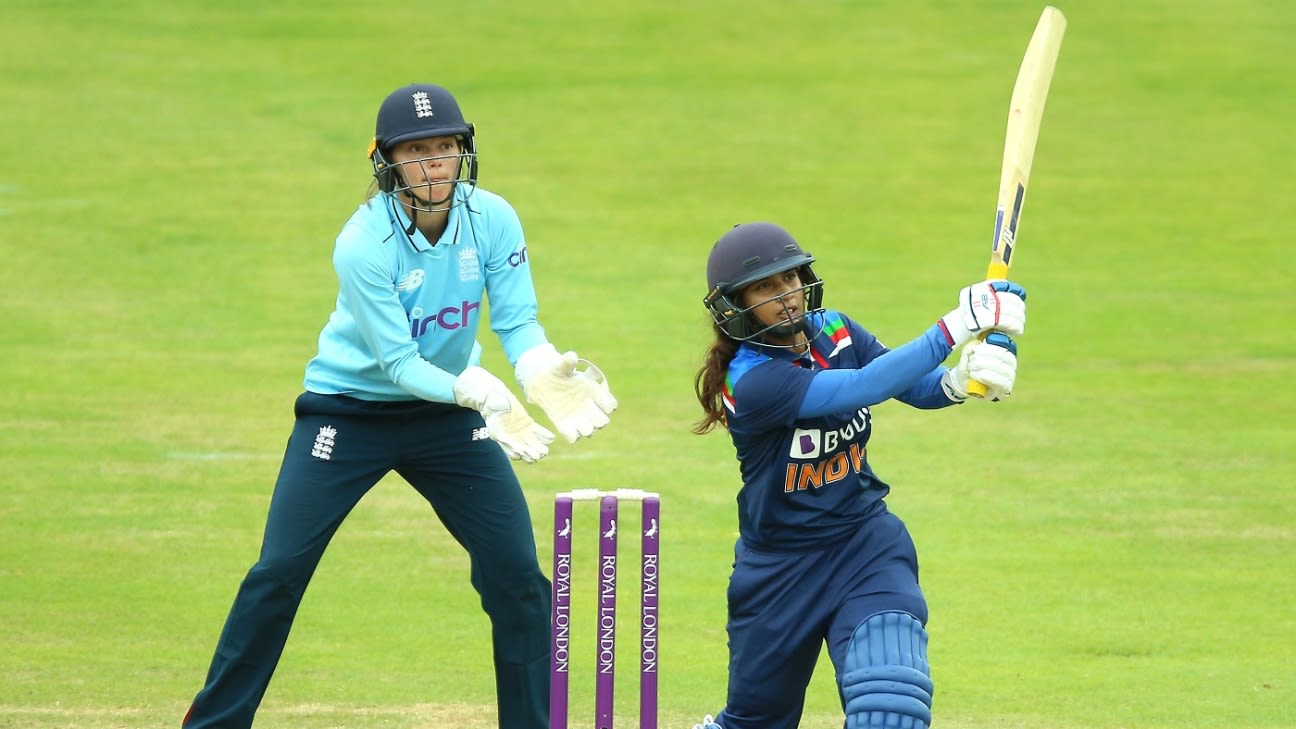Raj top-scored with a 108-ball 72 but aside from Verma, who made a 14-ball 15, no India batter could score at a 90-plus strike rate. England’s four-pronged seam attack did their part to keep a hold on the opposition’s scoring rate.
“Clearly, yes, we need to look into that aspect and work on rotating the strike,” Raj, the India Test and ODI captain, said afterwards. “Having said that, we require at least another top-order batter, in the top five, to get us the runs.
“We also need to understand that the England bowlers are very experienced, the seamers especially, [more so] than the seamers we have. They are bowling in their conditions; they know how to bowl in their conditions, and they really bowled well today.”
Asked if promoting herself to one-down could allow her to bat more freely, and India to make better use of their batting personnel, Raj said her decision to bat outside of the top order was anchored in longer-term scenarios.
“I think I’ve got most of my runs in the No. 3 slot, but it is also important to have batters in the side,” she said. “We can’t really fill [the line-up] with allrounders who sort of pitch in bowling or in batting. We need to have batters in the side who’ll score runs. If I go at No. 4, I’m also giving an opportunity for the team because I know for a fact that I’m not going to play forever. I also need to groom players in a sense when I am around, and guide them in the middle.”
Since the 2017 ODI World, India’s average first-innings total setting a target has been 213, the fifth-best tally as per matches played among the top nine ODI teams on the ICC rankings. With the next edition of the world tournament scheduled for March-April 2022 in New Zealand, India have their work cut out if they are to come close to catching up with Australia’s average first-innings score of 289 or defending champions England’s 259.
“Over the years, I’ve seen that we, the Indian team, are far more comfortable chasing a target because we know how to up our run rate,” Raj said. “But when it comes to posting a target, I guess there’s something we need to work on when and how we get to 250 because we can’t be going bang, bang and then lose wickets in the top order and you have the lower order to score those runs, like how we did today. That will take us to 200 or 210, but that’s not something we’d want.
“So, yes, as a batting unit, along with the batting coach, we need to sit down to find a way where, if we bat first, how we could try to put a total of 250 on the board and where we need to put on the acceleration and how we get our innings to do that.
Raj also rued the dearth of finishers in the domestic pool for India to scout appropriate talent from.
“Unfortunately, in our domestic competitions, most of the batters who get an opportunity are top-order [players] and they go on to score heavily,” said Raj, who leads heavyweights Railways on the domestic circuit. “Then they get picked for the Indian team and we all have batters who are top-orders in their respective sides.
“So, when it comes to finishers or lower-middle order or No. 6 or 7, we clearly don’t have players for that particular slot who have scored runs on the domestic circuit, so they walk into the team in that slot we’ve picked.
“Unfortunately, we don’t have anybody in that role right now but, yes, we’ll have to groom somebody who shows potential in that area. We are looking into that area. We have a few players in mind and groom somebody.”
“Clearly, our seam bowling [combination needs changing],” she said. “That puts a lot of pressure if you don’t get those wickets. When the spinners come in, a lot of pressure is on them to get wickets and even control runs. It’s not that they’ve done it before, but then [again], they can’t do it time and again. Somewhere, I think, we also need to groom our fast-bowling department.
“Other than Jhulan Goswami, the others who are there in the team, when they get an opportunity, they should be able to step up because these conditions do assist seamers, so they should be able to use these conditions to bowl well. So that’s one thing we really need to work on. Of course, it will be a constant answer that the batting line-up will have to fire at some point. So that’s what we’ll be looking into going into the second game.
“We’ll definitely look into the composition of the team and maybe a little more shuffle in our batting order to see that we can improve in things we have not really done well in this game today.”
Annesha Ghosh is a sub-editor at ESPNcricinfo. @ghosh_annesha
